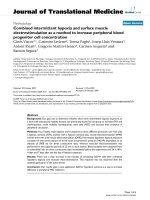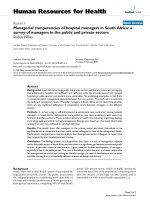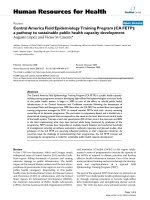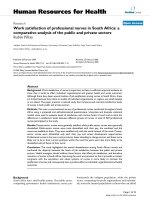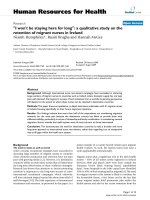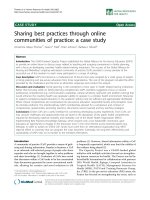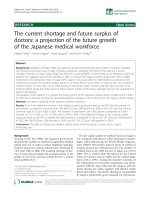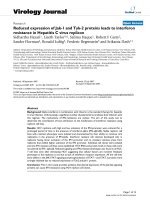báo cáo sinh học:" Central America Field Epidemiology Training Program (CA FETP): a pathway to sustainable public health capacity development" pdf
Bạn đang xem bản rút gọn của tài liệu. Xem và tải ngay bản đầy đủ của tài liệu tại đây (242.84 KB, 6 trang )
BioMed Central
Page 1 of 6
(page number not for citation purposes)
Human Resources for Health
Open Access
Review
Central America Field Epidemiology Training Program (CA FETP):
a pathway to sustainable public health capacity development
Augusto López and Victor M Cáceres*
Address: Division of Global Public Health Capacity Development, Coordinating Office for Global Health, Centers for Disease Control and
Prevention, 1600 Clifton Road MS E-93, Atlanta, GA 30333, USA
Email: Augusto López - ; Victor M Cáceres* -
* Corresponding author
Abstract
The Central America Field Epidemiology Training Program (CA FETP) is a public health capacity-
building training programme aimed at developing high-caliber field epidemiologists at various levels
of the public health system. It began in 2000 as part of the effort to rebuild public health
infrastructure in six Central American and Caribbean countries following the devastation of
Hurricanes Mitch and Georges in late 1998. Since then, the CA FETP has evolved from one regional
training programme managed by CDC to several national FETPs with each country assuming
ownership of its domestic programme. The curriculum is competency-based, and is divided into a
three-tiered training pyramid that corresponds to the needs at the local, district and central levels
of the health system. Trainees at each tier spend about 20% of their time in the classroom and 80%
in the field implementing what they have learned while being mentored by graduates of the
programme. FETP trainees have responded to multiple natural disasters and conducted hundreds
of investigations including surveillance evaluations, outbreak responses and planned studies. Also
graduates of the CA FETP are assuming influential positions in their respective ministries. As
countries meet the challenge of institutionalizing their programmes, the CA FETP concept will
increasingly be recognized as a model for sustainable public health capacity development.
Review
In late 1998 two hurricanes, Mitch and Georges, struck
widespread areas of Central America (CA) and the Carib-
bean region, killing thousands of persons and causing
extensive damage to public infrastructure. The health
impact of this natural disaster underscored the lack of pre-
paredness of governments in the region to react to a major
public health emergency. Responding to this public
health crisis, the United States Centers for Disease Control
and Prevention (CDC) in collaboration with the United
States Agency for International Development (USAID),
the American Association of Public Health Laboratories
(APHL), the Pan American Health Organization (PAHO),
and ministries of health (MOH) in the region imple-
mented a series of programmes to increase the capacity of
the MOHs to respond to disease priorities and develop
effective health information systems. Part of this invest-
ment prioritized training and service through the develop-
ment and implementation of a regional Field
Epidemiology Training Program (FETP).
The goal of the regional FETP (from here on referred to as
CA FETP) is to build public health epidemiological capac-
ity through training personnel to become high-caliber
field epidemiologists and strengthening disease surveil-
lance. The CDC has been a key technical partner, provid-
Published: 16 December 2008
Human Resources for Health 2008, 6:27 doi:10.1186/1478-4491-6-27
Received: 25 January 2008
Accepted: 16 December 2008
This article is available from: />© 2008 López and Cáceres; licensee BioMed Central Ltd.
This is an Open Access article distributed under the terms of the Creative Commons Attribution License ( />),
which permits unrestricted use, distribution, and reproduction in any medium, provided the original work is properly cited.
Human Resources for Health 2008, 6:27 />Page 2 of 6
(page number not for citation purposes)
ing scientific and programmatic support for the CA FETP.
In this article we describe the characteristics and evolution
of this training programme, which is unique in its history,
structure and implementation.
The CA FETP initiative includes five countries in Central
America (Costa Rica, El Salvador, Guatemala, Honduras,
Nicaragua) and the Dominican Republic. The training
programme was modeled after the highly successful CDC
Epidemic Intelligence Service (EIS) programme, a two-
year training programme that has strengthened disease
surveillance and response in the United States for over 55
years [1]. The EIS has been a model for more than 30
FETPs around the world, including the first one, initiated
in Thailand in 1980 [2]. Each country has adapted the
educational approach to its own unique needs. The CA
FETP was designed to address the health issues present in
the region and function effectively in the various political
systems. The CA FETP was initially built as a two-year,
master's (MPH) degree-accredited, training-in-service pro-
gramme in field epidemiology; this is the highest or
advanced level of training. In addition, because of the
urgent need for field epidemiologists at all levels of the
public heath system, two additional training tiers were
added (to form a three-tiered or "pyramid" programme)
to build capacity at local, district and central levels of the
health system.
In the initial years (2000–2002), the programme was
financed by USAID, as part of the Post-Hurricane Georges
and Mitch Reconstruction Project, and accredited region-
ally by the Universidad Autonoma de Nicaragua (UNAN) in
Managua. Subsequently, during 2003–2005, the pro-
gramme was financially supported through in-country
USAID funds and known as the Servicio de Investigacion
Epidemiologia y Vigilancia de Centro America, la Republica
Dominicana, y Haiti (SIEVCADH) Project. SIEVCADH was
a follow-on to the Post-Hurricane Georges and Mitch
Reconstruction Project and had the goal of continuing to
strengthen epidemiological practice, effective data use
and public health surveillance through a self-sustaining
regional FETP. Though initially included in the project,
efforts in Haiti ceased because of the adverse security situ-
ation at that time. During the third phase (2006 to the
present), also known as the transition period, the CA FETP
is evolving into several national FETPs financed primarily
through country-acquired funds with the individual
MOHs taking full responsibility for programme institu-
tionalization. This transition was begun in response to an
evaluation of the regional CA FETP in 2005 that con-
cluded that the programme, though initially effective for
rapidly increasing the number of field trained epidemiol-
ogists, was not sustainable in its then-current form.
Training model
The FETP approach is training through service, i.e. learn-
ing by doing. We will use the term "FETP" to refer not only
to the advanced level, but also to the entire three-tiered
programme unique to Central America. The three-tiered
concept (Figure 1), which has varied somewhat in its
implementation in each country, is now evolving into a
standardized and integrated approach, with a vision that
all countries share a common set of core competences at
each tier.
In the first tier, local health workers are trained in basic
epidemiological methods enabling them to better
respond to local health events and priorities. The first-tier
training is conducted over a period of three to five
months.
The second, more complex, intermediate tier is conducted
over a period of nine months with participants being
awarded a certificate by a university. Trainees for the first
and second tiers generally gather in the classroom for
three-day modules once each month and conduct their
fieldwork during the intervening periods.
The advanced, two-year FETP (third tier) includes a three-
week introductory module and several one- to two-week
modules, totaling nine weeks or about 360 hours (Figure
2), with an oral defense of a major research project
required to receive the master's degree (MPH).
The training at all three tiers is conducted in both the
classroom and, most importantly, in the field, where
trainees develop their skills and competences while per-
forming the day-to-day duties of a field epidemiologist
(surveillance, data analysis, outbreak investigation, etc.).
The proportion of time devoted to each activity empha-
sizes the field (80%) over the classroom (20%). Partici-
pants in the FETP continue to get MOH salary support,
because their fieldwork is considered to be part of their
day-to-day responsibilities within the MOH.
Because of the in-service nature of the training, tutors (i.e.
mentors) play a vital role. The design of the FETP pyramid
enables a cascade of mentorship in which trainees in
higher tiers serve as mentors to those in lower ones. The
recommended tutor-to-trainee ratio is one-to-one at the
advanced tier, one-to-two at the intermediate tier, and
one-to-five at the basic tier. Mentors for all tiers generally
receive training in mentorship skills prior to serving in
their role, though countries vary in the extent to which
this is implemented. Mentorship by CDC consultants was
especially important in the early years when the first
cohorts were being trained.
Human Resources for Health 2008, 6:27 />Page 3 of 6
(page number not for citation purposes)
The curriculum of the three-tiered training programme is
based on fundamental competences of a field epidemiol-
ogist [3]. It was constructed incorporating feedback and
experience in the region, using the methodological exper-
tise of an instructional designer. The competence areas
are: epidemiological methods, biostatistics, public health
surveillance, laboratory and biosecurity, communication,
management and leadership, computer technology, learn-
ing and mentorship for public health professionals, epi-
demiology of priority diseases and injury, and emergency
preparedness and response. Instructional materials for
several of these competence areas have been developed in
collaboration with the North Carolina Institute for Public
Health at the University of North Carolina School of Pub-
lic Health at Chapel Hill.
The curriculum (core and elective topics) is delivered pri-
marily in the classroom, and there are homework assign-
ments between modules. There is an increasing interest in
the use of innovative self-instructional and distance-based
learning (CD-ROM or Web-based) methods to comple-
ment the classroom training and provide more learning
options. However, since Web-based learning is a fairly
new approach in the region, incorporating this modality
into the FETP will be gradual and carefully evaluated.
FETPs around the world vary as to whether or not they
incorporate an academic degree, typically a master's
(MPH) degree. When the FETP was being planned in Cen-
tral America, the countries expressed their desire for mas-
ter's degree accreditation due to the importance of a
degree for professional advancement. During the transi-
tion period, accreditation for the CA FETP has been
moved from UNAN in Nicaragua to the University of del
Valle in Guatemala (UVG), which also accredits the Gua-
temalan national FETP. Since 2006 countries have been
Conceptual model of the pyramid training approach used in Central AmericaFigure 1
Conceptual model of the pyramid training approach used in Central America.
Pyramid FETP Model
Basic
Level
Mentorship
Cascade
Career Path
Intermediate
Level
Advanced
Level
Human Resources for Health 2008, 6:27 />Page 4 of 6
(page number not for citation purposes)
increasingly taking ownership of their respective national
FETPs and negotiating with local universities. Costa Rica
was the first country to achieve accreditation of its
national FETP by a local university, and similar initiatives
are ongoing in El Salvador and Honduras. Because of this
transition, as of 2007 we no longer speak simply of one
regional programme. Rather, there is one national pro-
gramme (Guatemalan FETP) that reaches out regionally
by accepting trainees from other countries (some with less
mature programmes). In addition there are several coun-
tries that together with Guatemala have formed a regional
coalition of independent, mutually supporting national
FETPs. In addition to planning joint initiatives, they sup-
port each other through sharing materials and experi-
ences.
Outcomes and impact
CA FETP trainees and graduates have improved health
policies and contributed to the strengthening of health
systems in their countries. During the period 2001–2007,
the CA FETP graduated four advanced-tier cohorts (58
trainees). Achievements by trainees during these years
include 181 surveillance systems evaluated, 222 out-
breaks identified and investigated, and 167 research stud-
ies implemented. In Guatemala and El Salvador, where
the training pyramid has been in effect the longest, there
have been 755 graduates from the basic tier (630 and 125,
respectively) and 255 graduates from the intermediate tier
(125 and 130, respectively). In Guatemala, El Salvador
and Honduras the FETP has played an important role in
the reorganization of national epidemiology offices. A
FETP trainee project in El Salvador led to the implementa-
tion of a new National Injury Surveillance system. FETP
investigations on chronic renal failure in sugar cane work-
ers in Nicaragua led to changes in national labour poli-
cies.
CA FETPs have also been active in responding to national
emergencies. During the 2001 earthquake in El Salvador,
all the trainees of the first regional cohort supported the El
Salvador MOH in various activities related to the disaster
(e.g. needs surveys, implementing surveillance systems,
investigating outbreaks). FETP trainees also responded to
recent disasters in Guatemala (Hurricane Stan, 2006) and
General time line for modules conducted by the Central American Regional FETP (advanced tier)Figure 2
General time line for modules conducted by the Central American Regional FETP (advanced tier).
Timeline of Modules for FETP
Planned
Investigation
Project
Management
Intro Course Surveillance
13 6 9 12
Prevention
Effectiveness
Selectives
13 15 18 21 24
Month
= Module
= Field Work
Human Resources for Health 2008, 6:27 />Page 5 of 6
(page number not for citation purposes)
Honduras (Hurricane Felix, 2007). During Hurricane Stan
there was a dramatic correlation between the quantity and
quality of surveillance data reported from an affected
health area and the presence of an intermediate-tier FETP
graduate. In addition to natural disasters, there have been
national-scale outbreaks in which FETP trainees played a
key role, such as those due to dengue (Costa Rica, Domin-
ican Republic, El Salvador, Guatemala); cholera (El Salva-
dor); vaccine-derived poliovirus (Dominican Republic);
hepatitis C (Nicaragua), pertussis (Costa Rica); and pesti-
cide poisoning (Dominican Republic, Guatemala, Nicara-
gua).
A measure of success for the programme is the number of
graduates that remain working within the health system
in their country (Table 1). Of current advanced-tier FETP
graduates, 80% still serve within their country's MOH, 5%
serve in international positions and 15% serve in other
institutions or are retired. Graduates of the CA FETP lead
national epidemiology offices in the MOHs of Guatemala
and Honduras. Some of the graduates have been con-
tracted as regional consultants for CDC programmes
(Global AIDS Program, Avian Influenza Program). A CA
FETP graduate from El Salvador is the current chairman of
TEPHINET (Training Programs in Epidemiology and Pub-
lic Health Interventions NETwork), the global network of
FETPs.
One strategy of the CA FETP is to promote the career path
of the epidemiologist by demonstrating the impact of a
network of field epidemiologists collaborating as teams
throughout various levels of the ministry of health. The
National Center for Epidemiology in the Guatemala
MOH has designed a project to implement field epidemi-
ologist networks in its health zones, based on the three
tiers of the FETP pyramid. The FETP trainees (or gradu-
ates) of the first, second and third tiers will work at the
local, district and zonal levels, respectively, and meet peri-
odically as a team to analyse surveillance and conduct
outbreak investigations and other public health interven-
tions. Standardized evaluations are being planned before
(baseline) and after implementation of these networks in
each province to demonstrate their impact on public
health practice.
Two other networks deserve mention. One of them is rep-
resented by the Regional Technical Committee (RTC),
composed of national epidemiology directors and FETP
coordinators. The leadership and political support shown
by the RTC for the programme have increased substan-
tially over the past two years. The RTC is led by a rotating
chairperson (appointed annually) and oversees the devel-
opment of the programme regionally. Monthly meetings
are held using Internet-based conferencing technology
and there is an annual meeting coordinated by the Pan
American Health Organization, at which a workplan is
developed and agreements are signed. The other network,
mentioned above, is TEPHINET [3] which has hosted
annual conferences and given opportunities for CA FETP
trainees to give their presentations in an international
forum. Most of the more than 200 international oral and
poster presentations given by CA FETP trainees and grad-
uates have been at the three global and four regional
TEPHINET scientific meetings that have taken place since
2001.
Conclusion
There has been great progress in the evolution of the
regional CA FETP into a coalition of national FETPs, but
important challenges remain. Though the countries share
a common history, culture and language, the political
cycles in each country vary, and each political change is
Table 1: Present positions of advanced-tier FETP graduates in Central America region, n = 58.*
Country Ministry of Health Other
Institutions**
International
health-related
organizations
Retired Total
Epidemiology
office
Other MOH
programmes
Local and
district
Costa Rica 6 1 7
El Salvador 6 219
Guatemala 6 3 1 1 1 12
Honduras 5 1 2 1 9
Nicaragua 3 3 1 1 1 9
Dominican Rep. 5 3 2 1 11
Panama*** 1 1
Total 32 4 11 3 5 3 58
Percentage 55% 7% 19% 5% 9% 5% 100%
*Data current as of 2007.
**Other institutions include other governmental or nongovernmental institutions, such as nongovernmental organizations (NGOs) and universities.
***Panama is included because there was a trainee residing there who received technical and financial support from the CDC Global AIDS Program.
Publish with Bio Med Central and every
scientist can read your work free of charge
"BioMed Central will be the most significant development for
disseminating the results of biomedical research in our lifetime."
Sir Paul Nurse, Cancer Research UK
Your research papers will be:
available free of charge to the entire biomedical community
peer reviewed and published immediately upon acceptance
cited in PubMed and archived on PubMed Central
yours — you keep the copyright
Submit your manuscript here:
/>BioMedcentral
Human Resources for Health 2008, 6:27 />Page 6 of 6
(page number not for citation purposes)
often accompanied by turnover in health authorities that
oversee the national FETPs. In establishing each national
FETP, each country must negotiate its own domestic
accreditation agreement while conforming to a regional
standard with regard to competences and field supervi-
sion.
One of the key challenges of the CA FETP is the long-term
sustainability and institutionalization of FETPs in each
country. For this to occur, each national programme must
ideally be financed by its inclusion as a line item in the
MOH budget. External donors may continue to play an
important role in providing support to FETPs, but in this
period of transition, it is now individual countries that
conduct these negotiations and agreements. Along with
national financing, other indicators on the path to sus-
tainability are: (1) the inclusion of the FETP in the organ-
igram of the MOH; (2) the presence of a full-time FETP
director; (3) well-defined job functions that allow epide-
miologists within the MOH to practice skills acquired dur-
ing training; and (4) a career ladder that rewards advanced
training in field epidemiology.
The CA FETP has recently been promoting the concept of
academic networks. As each country moves forward to
establish accredited programmes with local universities, it
will be important that these universities collaborate to
facilitate adherence to a core curriculum and exchange of
professors/tutors, trainees and course credits. In this man-
ner, lessons will be shared and synergies created. We see
great potential for the Internet as a medium for commu-
nication and delivery of course content. Over the next year
the CA FETP will be pilot-testing and evaluating training
modules administered over the Internet. If this roll-out is
successful, it will greatly enhance each country's range of
options for training in field epidemiology and enhance
the sustainability and caliber of national programmes.
TEPHINET and the RTC will continue to play a vital net-
working role. In addition to enhancing the scientific rig-
our of the programme, the annual TEPHINET meetings
will continue to serve as an important forum for the coun-
tries in the CA FETP to exchange experiences with other
FETPs around the world. We have recently seen increased
interest by FETPs in South America and Asia in establish-
ing their own "training pyramids." At a recent leadership
workshop in Guatemala City, members of the RTC met
with representatives from the four FETPs in South America
(Argentina, Brazil, Colombia and Peru) and discussed a
broader collaboration to enhance regional sustainability
of all FETPs.
In conclusion, the CA FETP has made an important con-
tribution on field epidemiology practice in the Central
American region. As countries continue to take full own-
ership of their national programmes and institutionalize
them, the CA FETP experience will increasingly serve as a
model for sustainable public health capacity development
in the region and beyond.
Competing interests
The authors declare that they have no competing interests.
Authors' contributions
Both authors contributed to the conceptualization, draft-
ing and finalization of this manuscript.
Acknowledgements
The authors would like to acknowledge the hard work and dedication of
the trainees and mentors of the CA FETP who have been responsible for
the success of the programme. They would also like to recognize Dr Gloria
Suarez, Dr Carlos Alonso, Ms Gabriela Illescas, Ms Denise Traicoff, Mr
Nabil Ahmed and Ms Senia Espinosa for their outstanding contributions to
the CA FETP and to thank Dr Patricia Simone and Dr Henry Walke for
their helpful review of the manuscript.
References
1. Thacker SB, Dannenberg AL, Hamilton DH: Epidemic Intelligence
Service of the Centers for Disease Control and Prevention:
50 years of training and service in applied epidemiology. Am
J Epidemiol 2001, 154:985-992.
2. White ME, McDonnell SM, Werker DH, Cardenas VM, Thacker SB:
Partnerships in international applied epidemiology training
and service, 1975–2001. Am J Epidemiol 2001, 154:993-999.
3. Traicoff DA, Walke HT, Jones DS, Gogstad EK, Imtiaz R, White ME:
Replicating success: developing a standard FETP curriculum.
Public Health Reports 2008, 123:28-32.
